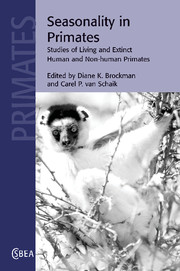Book contents
- Frontmatter
- Contents
- List of contributors
- Preface
- Part I Introduction
- Part II Seasonal habitats
- Part III Seasonality and behavioral ecology
- Part IV Seasonality, reproduction, and social organization
- Part V Seasonality and community ecology
- 15 Seasonality and primate communities
- 16 Primate diversity and environmental seasonality in historical perspective
- Part VI Seasonality and human evolution
- Index
- References
16 - Primate diversity and environmental seasonality in historical perspective
Published online by Cambridge University Press: 10 August 2009
- Frontmatter
- Contents
- List of contributors
- Preface
- Part I Introduction
- Part II Seasonal habitats
- Part III Seasonality and behavioral ecology
- Part IV Seasonality, reproduction, and social organization
- Part V Seasonality and community ecology
- 15 Seasonality and primate communities
- 16 Primate diversity and environmental seasonality in historical perspective
- Part VI Seasonality and human evolution
- Index
- References
Summary
Introduction
The nature of the relationship between organisms and their environment has figured prominently in studies of evolution and ecology for over a century. Of particular interest has been the investigation of how climatic and environmental changes influence the course of animal evolution, and specifically how important environmental change may be relative to other factors such as migration, predation, and competition, if, in fact, its influence can be isolated sufficiently from these others to be tested. Some of the important questions that have been framed on this topic include: How are animals buffered against their environment? Why do different species appear to respond differently to environmental change? What kinds and degrees of environmental change are sufficient to induce range shifts or the “retuning” of anatomical or physiological tolerances? How directly or immediately do climatic and environmental change influence the origination or extinction of species? These questions have been the subject of many recent and important studies of mammalian evolution and diversification (e.g. Vrba [1985]; McKinney [1998]; Behrensmeyer et al. [1997]; Alroy et al. [2000]; Hooker [2000]) and have begun to figure prominently in discussions of the more specific context of primate evolution (e.g. Reed [1999]; Jablonski et al. [2000]). Different species of mammals have responded differently to changing patterns of environmental seasonality through time, coping by means of combinations of geographical range shifts and evolution of new ecological strategies, or not coping by extinction (Hooker 2000; Jablonski et al. 2000).
- Type
- Chapter
- Information
- Seasonality in PrimatesStudies of Living and Extinct Human and Non-Human Primates, pp. 465 - 486Publisher: Cambridge University PressPrint publication year: 2005
References
- 1
- Cited by



